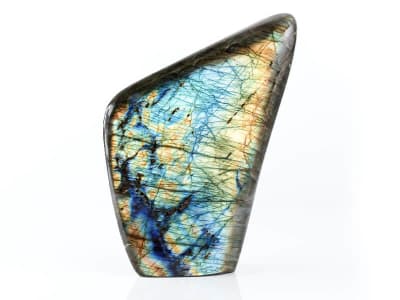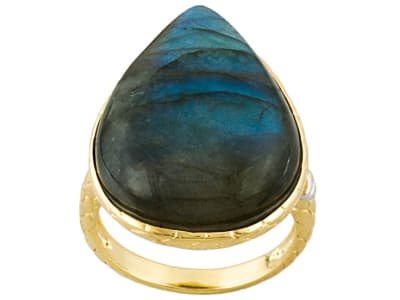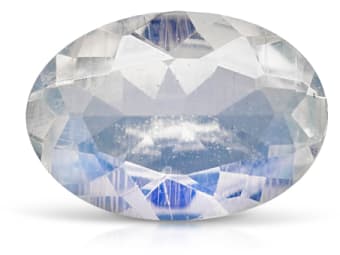Labradorite is a plagioclase feldspar. When most people think of labradorite they think of the phenomenal variety that shows labradorescence, but it also comes in transparent yellow labradorite, Oregon sunstone, rainbow and blue moonstone varieties. The labradorescencent variety shows iridescent colors caused by the interference and refraction of light passing through different layers in the material. Yellow labradorite is faceted for use in jewelry. Oregon sunstone displays aventurescence due to inclusions of copper platelets. Rainbow moonstone is transparent and has a rainbow color adularescence. Blue moonstone is fine moonstone from India. The adularescence in both moonstone varieties are due to the repeating feldspar layers scattering the light as it enters the stone.
General Information
LWUV: Inert to weak white
Labradorite Colors
-
 Black
Black -
 Brown
Brown -
 Colorless
Colorless -
 Gray
Gray -
 Green
Green -
 Red
Red -
 White
White -
 Yellow
Yellow -
 Yellow
Yellow
Alternate Names
Spectrolite
Countries of Origin
Myanmar; Cameroon; Papua New Guinea; Paraguay; Portugal; Greece; Mongolia; El Salvador; Korea (the Republic of); Morocco; Unknown; Brazil; Chile; Nepal; Tonga; Hungary; Japan; Ukraine; Taiwan (Province of China); India; New Zealand; Canada; Namibia; Finland; Italy; Peru; Ethiopia; Germany; Tanzania, United Republic Of; Russian Federation; Czechia; United States of America; Egypt; Madagascar; Thailand; United Kingdom of Great Britain and Northern Ireland; Costa Rica; Saudi Arabia; Sweden; Pakistan; China; Poland; Slovakia; France; Kyrgyzstan; Spain; Cuba; Saint Lucia; Norway; Dominican Republic; Mexico; Israel; Greenland; Tajikistan; Indonesia
History
Labradorite exhibits that same compelling rainbow of light-against-darkness. It displays breathtaking color. Labradorite is a sanidine feldspar. The beautiful rainbows that it emits have a metallic-like iridescence that is called labradorescence. This is caused by the interference and refraction of light as it enters and passes through the stone. Blues and greens dominate, but look closely and you'll see reds, yellows and oranges frolicking in the light.
Care
Clean with warm water and gentle soap; dry thoroughly with a soft cloth. Do not use ultrasonic cleaners and avoid harsh chemicals. Labradorite is a 6 - 6 ½ on the Mohs scale. It is seldom treated but may occasionally be oiled.
More About Labradorite
It's unique. It's color-rich. Wonderful legends have grown up around this stone. Some people believe that labradorite will help you become the person that you are meant to be. An Inuit tale says that, a very long time ago, the Northern Lights fell from the sky and were trapped inside some rocks off the coast of Labrador. An Inuit warrior, seeing the trapped lights, tried to release them. He struck the rocks again and again with his spear, but try as he might, he couldn't release them all. According to the legend, some of the lights remain trapped in the beautiful stones that are labradorite. The next time you wear a piece of labradorite jewelry, imagine that you are wearing your very own piece of the Northern Lights. It's a lovely vision.
Species/Variety
Yellow Labradorite
Transparent yellow labradorite is a favorite of lapidaries. Crystals can be quite large and can yield gems over 15 carats. The material is perfect for fantasy and specialty cuts. Yellow labradorite can be found in Mexico, Oregon, and Ethiopia. The Mexican material is found at the foot of the Sierra Madre Occidental mountain range. The Oregon and the Ethiopian material is called sunstone when it contains copper platelets.
Optical Phenomena
Spectrolite
Spectrolite is the tradename for the phenomenal labradorite from Finland. Spectrolite is known for its colorful and striking iridescence that shows blue, green, yellow, orange and red colors.
Labradorescent
Displaying brilliant pastels and deep golden colors, labradorite features a spellbinding "black rainbow" of color. When appreciating the iridescent play of colors known as labradorescence, observe the strength and intensity by viewing from different angles, as different colors or even a range of colors may be visible from different positions.
Sunstone (Labradorite)
Labradorite sunstone was only thought to be found in Eastern Oregon until 2015 when a variety labradorite-bytownite feldspar was discovered in the Afar region of Ethiopia. The three Oregon mines are the Dust Devil, Ponderosa and the Sunstone Butte. Stones can be near-colorless, green, red, yellow or combinations of these colors. The stones have tiny copper platelet inclusions that cause schiller or adventurescence.
Rainbow Moonstone
Adularescent labradorite with a multi-colored glow is sometimes called rainbow moonstone. Rainbow moonstone is colorless and highly transparent, and it displays an amazing optical phenomenon called adularescence. It is a plagioclase feldspar and a member of the triclinic crystal system. Internally repeating feldspar layers scatter the light that enters the stone creating a mystical glow reminiscent of moonbeams. This glow comes to life, rolling across the gems surface, when it is moved.







